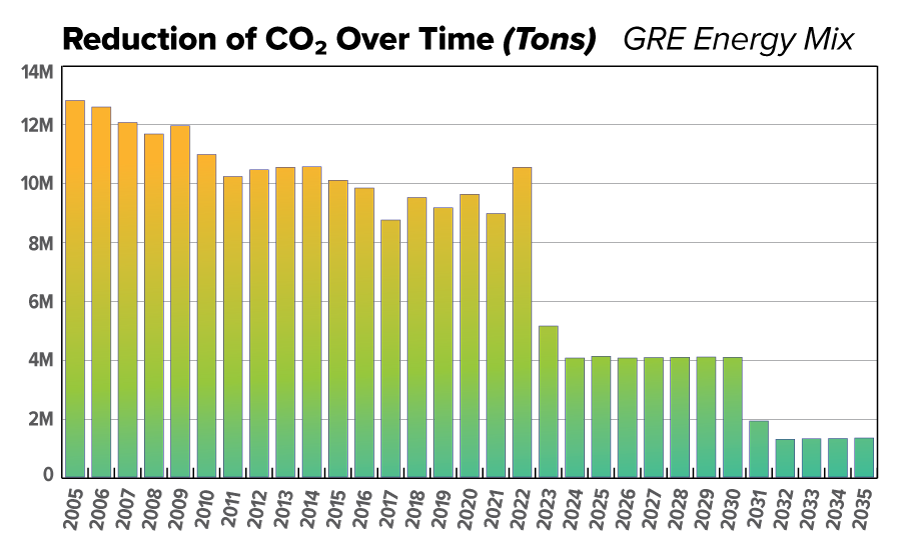As we wait for the remaining approvals to be obtained in order to close the sale of Coal Creek Station to Rainbow Energy, LLC and the corresponding High Voltage Direct Current (HVDC) transmission line to Nexus, LLC, I wanted to share with you some information I find interesting regarding the impacts of the anticipated sale of Coal Creek Station and the projected Great River Energy (GRE) energy mix transition as a result of such sale.
Power supply actions since 2005 have led to the systematic decrease of carbon emissions in GRE’s power supply portfolio. DryFining at Coal Creek Station, the exit of large coal-based contracts, retirement of Stanton Station, co-firing of Spiritwood Station, and the addition of hundreds of megawatts of wind are projected to decrease the total tons of CO2 in the portfolio from more than 12 million tons annually, in 2005, to just over 1 million tons projected by 2035. This aggressive decarbonization not only does its part to reduce the worst impacts of climate change, but it also insulates GRE’s members from regulatory risk associated with carbon governance policies. In addition, these forward-thinking actions were accomplished at an incredibly efficient cost, with the future rate forecast for GRE’s wholesale rates being lowered as a result of the anticipated sale of Coal Creek Station, which should allow continued rate stability for our members. As we move ahead, GRE’s new power supply portfolio will serve LREC for decades with cost-competitive renewables and market energy while retaining a modern fleet of natural gas and oil-fired peaking plants to ensure reliable electric service. Also, as stated in one of my prior columns, GRE plans to add 900 MW of wind energy by 2023, more than doubling its renewable energy.

The prior actions taken by GRE since 2005 together the projected transition of GRE’s energy mix is anticipated to result in a reduction of CO2 by approximately 11 million tons from 2005 to 2035, with a significant reduction starting in or around 2023. To give the above text and corresponding graph some perspective, please take a look at the following examples and information that I obtained by utilizing the “Greenhouse Gas Equivalencies Calculator” available on the United States EPA website:
- 11 million tons of CO2 is the equivalent to greenhouse gas emissions from 2,392,279 passenger vehicles driven for one year and 27,645,176,580 miles driven by an average passenger vehicle.
- 11 million tons of CO2 is the equivalent to CO2 emissions from 1,237,763,025 gallons of gasoline consumed and 1,080,550,098 gallons of diesel consumed, the electricity use of 1,998,069 homes for one year, and 1,338,069,111,058 smartphones charged.
- 11 million tons of CO2 is the equivalent to carbon sequestered by 181,887,329 tree seedlings grown for 10 years, 13,476,953 acres of U.S. forests in one year, and 75,203 acres of U.S. forests preserved from conversion to cropland in one year.
 Although we cannot be certain the Coal Creek Station transaction will be closed because it is contingent upon obtaining some additional approvals out of LREC’s control, we can be certain LREC will continue to listen to its members and their goals in order for LREC to be successful for generations to come!
Although we cannot be certain the Coal Creek Station transaction will be closed because it is contingent upon obtaining some additional approvals out of LREC’s control, we can be certain LREC will continue to listen to its members and their goals in order for LREC to be successful for generations to come!

 Lake Region Electric Cooperative
Lake Region Electric Cooperative